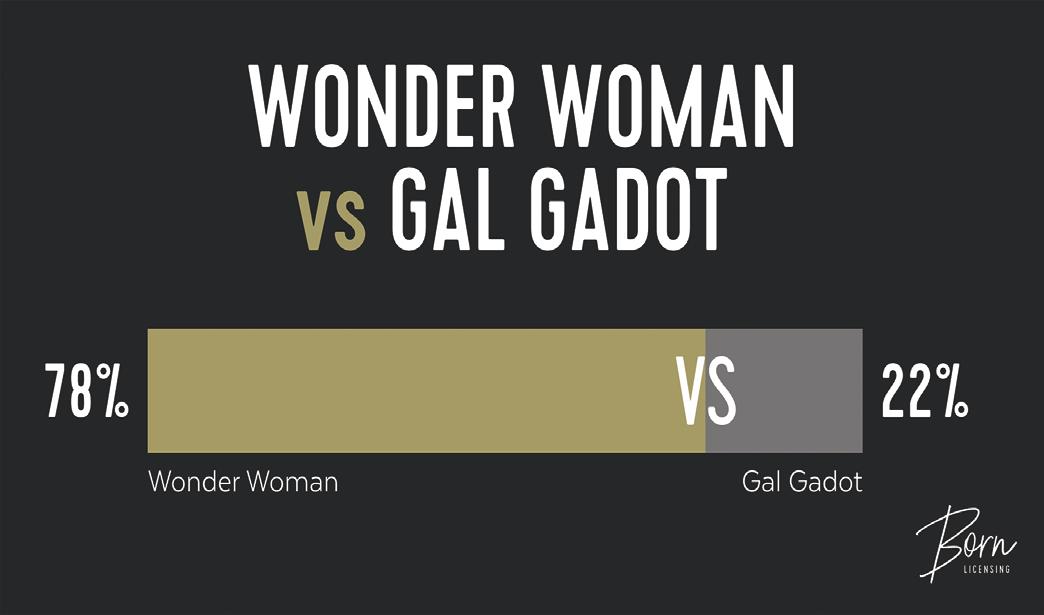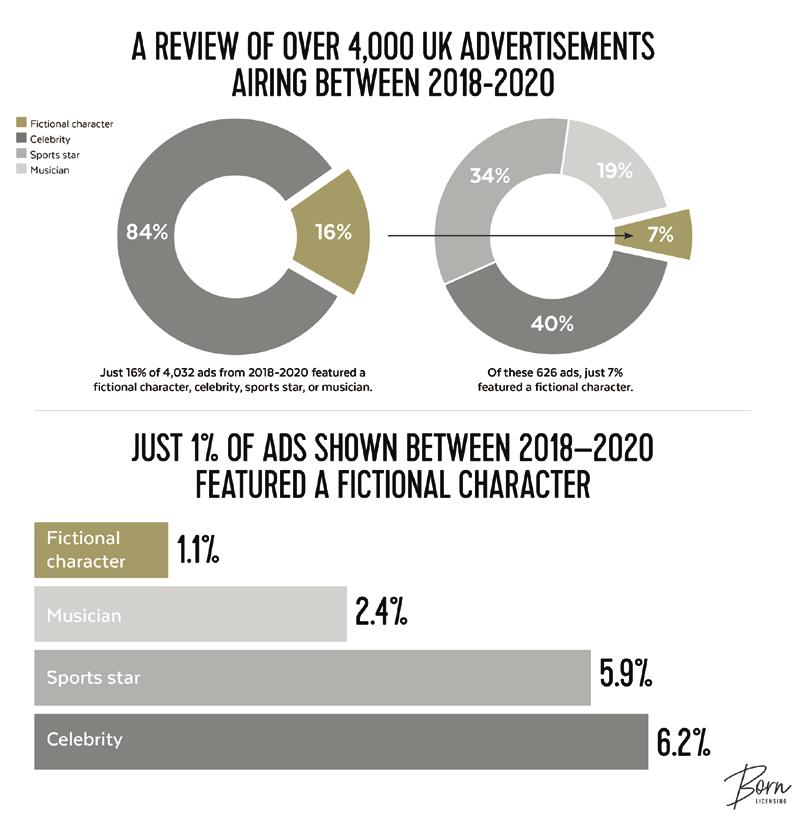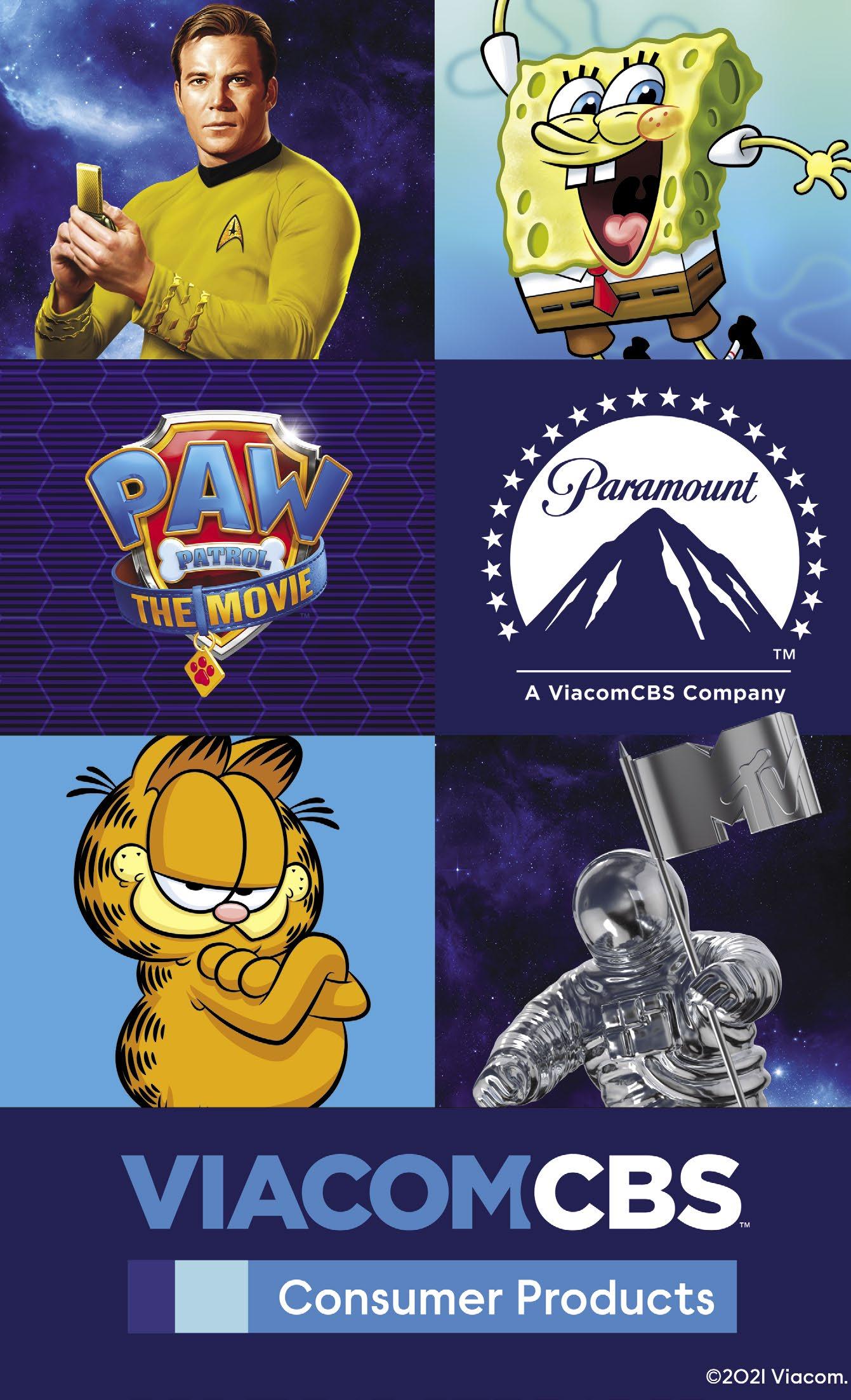
8 minute read
A Case for Characters in Advertising
A CASE FOR CHARACTERS
Born Licensing is focused solely on the licensing of entertainment based IP for the purposes of advertising and marketing.
Founder David Born and his team have a deep understanding of how the licensing industry works and how advertising agencies and brands can license their intellectual property.
In this article, following on from the publication of their recent White Paper, David Born and Amber Cheung look at why fictional characters are under-used in advertising campaigns.
While there has been a significant level of research into the use and effectiveness of celebrity endorsements, there is surprisingly little research into the use of fictional characters in advertising. We regularly see celebrities used in advertising in an effort to add credibility, create a conversation and increase brand awareness, while fictional characters, whose impact could be even greater, are often overlooked. Fictional characters can be a powerful tool for advertisers. They can instantly bring with them broad awareness, a loyal fan-base and positive attributes to align with a brand. They have the ability to tap into a range of emotions and memories. They can also pose a smaller risk than celebrities, as they’re much less likely to be associated with any scandals that could negatively impact a brand. So, with the benefits clear to us, why is it that fictional characters appear in advertising significantly less than celebrities? We set out on a journey to investigate how and why fictional characters are under-utilised in advertising. The following is a summary of our white paper, which we believe is the first indepth research of its kind.
What do the UK public think about fictional characters in advertising?
A White Paper by David Born and Amber Cheung from Born Licensing
Based in London, Born Licensing has recently been named by the Financial Times as the 58th Fastest Growing Company in Europe.

Source: Ipsos MORI survey 27 November 2020 n=999 adults aged 16-75 in the UK who selected either a famous character from a film, TV show or animation, a celebrity, a famous music artist or a famous sports star.
In a survey conducted by Ipsos MORI, a global leader in market research, the UK public told us overwhelmingly that they most like to see fictional characters in advertising when compared to celebrities, musicians and sports stars. When respondents were asked what they most like seeing in an advertisement, fictional characters were chosen 73% more than celebrities and musicians, and 111% more than sports stars.
We also established that in comparison to celebrities, musicians, and sports stars, fictional characters were more likely to capture the UK public’s attention, make people remember the advert the next day, make people want to tell their friends or share on social media, and make people like the brand. We discovered that characters and celebrities are considered almost equally likely to make people want to purchase a product or a service – something that would probably surprise many.
Furthermore, fictional characters outshine the celebrities best known for playing them. For example, when asked who would most likely capture their attention in an ad out of Wonder Woman or Gal Gadot, 78% of the UK public selected the fictional superhero over the stunning actress that currently plays her.
Similarly, when asked to select 5 characters that would capture their attention from a line-up of 8 fictional characters (such as Shrek or SpongeBob) and 8 brand characters (such as Tony the Tiger and Ronald McDonald), the UK public chosen fictional characters 54% of the time.
How often are fictional characters used in advertising compared to celebrities, musicians, and sports stars?
In a review of over 4,000 UK advertisements aired between 2018-2020 we discovered just 1% of ads featured a fictional character. 16% of UK ads featured a fictional character, celebrity, sports star or musician. Of this 16%, celebrities were the most common endorsement type (40%) followed by sports stars (34%), musicians (19%) and lastly fictional characters (7%).
In other words, an advert in the UK is 13.4 x more likely to feature a celebrity, musician, or sports star than a fictional character. This revelation helped confirmed our suspicion that despite their clear benefits and popularity, fictional characters are significantly under-utilised in advertising.
Why are fictional characters under-utilised in advertising?
Talent agencies are robust and wellresourced. While celebrities, musicians and sports stars have agents hunting down endorsement deals all year round, fictional characters don’t have anywhere near that level of proactive representation. (In fact, to our knowledge, Born Licensing is the only agency in the world focusing solely on character licensing in advertising).
Celebrities have had agents representing their commercial interests for over a century. Writer Mark Twain was reported to have endorsed products including cigars and flour as early as 1895. Today endorsement deals play a big part of the talent agent role, and it’s big business. It has been reported that celebrity Kylie Jenner has made as much as US$1m for a single sponsored post on Instagram, music star Beyonce is said to have been paid $50m for signing a contract with Pepsi, and Tiger Woods is reportedly worth over $800m, but only 10% of that is from prize money. With celebrities, musicians and sports stars generating this kind of revenue, there’s no wonder why the talent agency industry has sufficient resource, funded in large part by their 10% commission.
In contrast, Rights Holders as a whole are focused on box office, streaming deals and their own streaming services. Even within the licensing divisions, there naturally tends to be a focus on the categories that generate consistent royalty revenue year after year. Little resource is dedicated to their characters being licensed in advertising due to the sporadic nature of the deals, and most of the time it is on a reactive basis, i.e., character licensing will be considered if and when brands approach a Rights Holder, not the other way around.
In addition, there are a number of barriers that make it difficult for professionals in the advertising industry to use fictional characters in their work. From our research

Source: Ipsos MORI survey 27 November 2020 n=1063 adults aged 16-75 who selected either fictional characters or celebrities.

Source: A review of 4,032 UK ads listed on sourcecreative.com
we discovered that 100% of Creatives and 61% of Producers experienced having a project with fictional characters shelved. The most common reason for projects being abandoned were the licensing fees being too high.
This indicates that brands may not be willing to invest the required amount (of time or money) for licensing fictional characters, or that they don’t see the value and as a result choose a different script. It could also indicate that fictional characters are not being considered upfront and are only looked at when the production budget has already been set.
One Creative Director said to us, “It feels like there are so many hurdles that (licensing fictional characters) is often something that is disregarded quite soon in the process.” A Producer told us the reason why they feel licensing fictional characters is more difficult than licensing music or hiring a celebrity came down to simply not having the previous experience.
Are fictional characters less risky for brands than celebrities?
One of the most interesting pieces of research we discovered was a study undertaken in collaboration with Monash University. The study looked specifically at comparing film personas and the celebrities who play them when creating effective brand endorsements.
The study concluded that film personas are likely to be shielded from the negative consequences of a celebrity transgression, which is more likely to protect the brand they’re endorsing from risk.
Ms Amanda Kennedy, Sessional Academic (Marketing) at University of Newcastle, one of the authors of the study says, “Consumer attitudes towards the film personas should not be impacted by the actions of the corresponding celebrity.” There are countless examples of celebrities’ bad behaviour leading to cancelled advertising campaigns, damaged brands and pulled endorsements. A UK example comes as recently as January 2021 when EE dropped their latest campaign featuring Rita Ora after the singer breached quarantine and lockdown guidelines issued by the UK government. Another example is Jeep’s 2021 Super Bowl advertisement starring Bruce Springsteen, which was recently taken off air following reports of the musician driving under the influence. The commercial was reinstated after charges were lifted a few weeks later.
From this study it appears that brands and advertisers who choose to appoint a famous character as their brand ambassador would certainly have a lot less risk to manage. In addition, they would also enjoy the benefit of the characters giving their consumers a higher intention to purchase their product or service.
So, what next?
In our white paper we use our extensive research and experience to identify seven areas in which we believe change can be made in order to see advertisers utilise fictional characters more. (Download a copy to find out what these seven points are!)
Many advertising and marketing greats talk about the importance of storytelling. We believe that it makes sense to work with fictional characters that appear in some of the most popular, well-known and cherished stories in the world. This white paper focuses solely on the UK market. The next step is to see if these conclusions are shared in other markets, particularly, in the US where characters have been more commonly used in advertising. We hope this report will help raise the profile of character licensing within the advertising industry, as it’s our mission to see fictional characters in advertising as often as celebrities, musicians and sports stars.
Readers can download your copy of A Case for Characters here. https://bornlicensing.com/a-case-forcharacters










